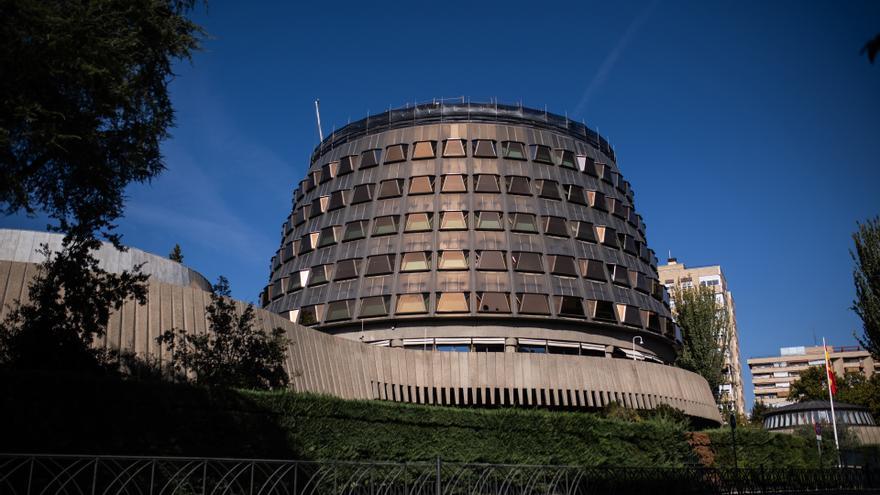On January 31, 2007, the then president of the Community of Madrid, Esperanza Aguirre, laid the first stone of what was going to be a megaproject to centralize all the judicial headquarters in the region, which, even then, were very deteriorated. Almost two decades later, the sketch of what was going to be the City of Justice only remains a vacant lot with a half-finished building after an expenditure of 100 million euros, a court ruling that proves the rigging of many of its contracts and the promise of a new judicial complex that will take at least six years. And, meanwhile, its supposed beneficiaries continue to suffer from even more deteriorated judicial headquarters, where breakdowns are increasingly frequent and serious.
Just a few weeks ago, the false ceiling of the courtroom of one of the investigative courts in Plaza de Castilla fell off and the floor flooded. Its officials had to manage to make the aforementioned statements in another room. Last Wednesday they were able to hold trials again – 16 in a single morning – but several witnesses confirm that the musty smell was still very strong despite having the window open at all times. The floorboard was also still buckled. “It is a constant danger. There is not a day that something does not happen,” says Julia Damià, CCOO prevention delegate.
The unions have reported that in recent months the false ceilings of several courts have collapsed due to the accumulation of water due to the deterioration of the pipes, which has also caused supply cuts. The situation was especially complicated this summer, when failures occurred in the air conditioning of several judicial headquarters. “Up to five people suffered lipothymia as a result of the high temperatures. It is undignified to have to receive in these conditions people who, after months and even years of waiting, are risking compensation for a dismissal or being granted a disability,” says a magistrate. Other officials talk about the “lack of work materials” and even personal hygiene, such as hand soap or toilet paper.
The Social Courts are located in a building on the central Princesa Street, next to what is known as Plaza de los Cubos. They moved to that property, now property of Merlin real estate agencywhen the Community of Madrid sold the building in which many of them were located, on Hernani Street, for 62 million euros in 2006. The objective was to obtain liquidity for the construction of the later failed City of Justice, which architects such as Norman Foster were going to design.
But the economic viability of that project was based on the good sales of the old judicial buildings. A rain of millions in full boom real estate that caused the sketch of the City of Justice to go from projecting an expense of 1,000 or 1,100 euros per square meter to considering the figure of 2,000 or even more, as explained in a parliamentary commission in the Madrid Assembly by the one who He was a Campus advisor in 2008 and collected the newspaper The Country.
Meanwhile, what was thought to be a temporary solution has become eternal over time after the failure of that first plan to unify headquarters. A circumstance of great impact for the public coffers, since the Community of Madrid spends each year more than forty million euros for rent judicial headquarters that are not their property.
This provisional nature can also be seen in the state of the facilities on Princesa Street. Some courts do not have ventilation or natural light. The public waiting rooms are very small and shared for up to eight courts, which means that dozens of people gather in them every day, including plaintiffs, defendants, witnesses, lawyers… “In summer it is suffocating. “They are not decent conditions for workers or citizens,” says an official.
Four days without running water
In the courts of Plaza de Castilla, north of the capital, the situation is almost worse. “Every year, with the change of season, situations of lack of heating or cooling occur for a few days as a result of poor maintenance,” explains Damià. After many years of patches, that summer the pump broke down and the facilities spent four days without running water and with temperatures above 32 degrees, according to the unions.
The Plaza de Castilla complex is made up of several buildings that occupy an area of more than 50,000 square meters and where there are guard courts that remain open and in operation 24 hours a day. Around 5,000 people, including workers and the public, pass through there every day.
The extreme situation this summer forced the Ministry of Justice to make a move, which put out to tender an emergency contract of 2.5 million euros thanks to which new autonomous equipment was purchased and “daily measurements with calibrated thermometers” were carried out. , according to the Ministry of Justice. A spokesperson for this department assures that since 2017, 6.5 million euros have been invested for the “maintenance, improvement and rehabilitation” of this building. The department declined elDiario.es’ request to be able to access the building to check its condition in situ because it was under “construction” and only allowed “entry to people who are going to trial.”
The aforementioned spokesperson affirms that only in recent months, the regional government has carried out specific work on this property, such as renovating the assembly hall or cleaning the facades and windows, as well as signing a new maintenance and cleaning contract, with larger budget and new company in charge of this work. However, among its workers, the feeling of total inattention.
“It is an absolute abandonment,” summarizes another official with years of experience. “When the false ceiling of my courthouse came off, there was water everywhere. In the bathroom it looked like a shower. When it is not one thing it is another,” he adds. “In the courtroom on duty there is almost always something broken and it is very frustrating because it delays our work and we have people in front of us in very difficult situations,” says another. “I have been stationed here for 15 years and they have cleaned the windows once. It is just one more example of the Administration’s negligence,” points out a third.
Added to the poor situation of infrastructure is a high volume of work. And the fact of having to face citizens who, sometimes, have been waiting for months and even years for a lawsuit to be resolved. A situation that contributes to further increasing the image of Justice, which suffers from an endemic lack of resources. “Now we are signaling urgent layoffs for June 2026,” says an official. That is, more than two years away. For claims for amounts – an unpaid salary, for example – the delay is even longer, until May 2027.
In 2023, 1,023,755 matters entered the Community and 971,115 were resolved, according to the memory of the Superior Court of Justice of Madrid (TSJM). However, at the end of the year a total of 606,366 remained unresolved in the drawers. A figure on the rise since 2022, when half a million pending matters were exceeded for the first time.
Beyond these inevitable patches, the gaze of the Government of Isabel Díaz Ayuso is now directed at resuming the macro-project of the City of Justice in the same Valdebebas wasteland that witnessed the failure of Aguirre’s initiative. But the project will be carried out in several phases and the works will take at least six years.
The Madrid Justice workers still have more than five years ahead of them in buildings that were already very deteriorated two decades ago, when they began to talk about the reunification of headquarters. “The general feeling of the staff is that they do not feel safe in their job, that this would not happen in a private company. It is one more example of the deterioration of public affairs,” says the CCOO representative.













Add Comment